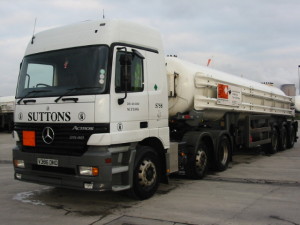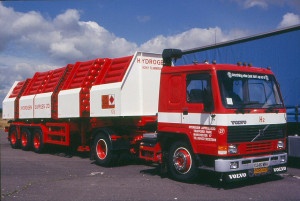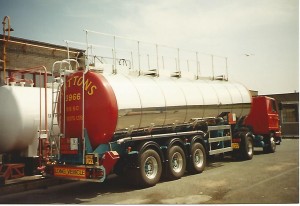By the time the Shift Process Managers manual was written in 2003 almost all raw materials were delivered to site by road. Details of Transport is shown in the other menu.
The correct receipt and monitoring of raw material usage’s and stock is an important part of the SPMs job. The Process Record clerk calculates the normal needs based on production requirements and operator’s stock tank readings. The information on most of the raw materials is communicated to the SPM via the Sales.xls or Rawmats.xls spread sheets.
However the SPM must be continually mindful of the effect changes to the process production plant can have on raw material stocks and usage and make changes as required. If changes are made it is very important the process record clerk is made aware of the changes on his return to work.
Minor changes to deliveries will normally be made by the SPM by phone to the relevant supplier. However in times of difficulties members of the Supply Chain or the Duty Manager may be contacted for assistance, it is important that any changes to a planned delivery is communicated effectively to the production planning section.
It is important that all drivers of raw material tankers are aware of the correct speed and routes to use both on and off site. Tankers are normally only allowed to leave site between 06:00 and 23:00. The release of tankers outside this time is at the SPM’s desecration.
Liquid nitrogen is delivered in road tankers via a “milk round” type delivery. The tank level is indicated local but can also be read remotely by Air Products who supply the material. The tanker driver is totally responsibly for connecting to the bulk tank and transfer of liquid to it. The bulk tank has a number of air heated evaporators which supply nitrogen gas at around 10 bar to the site gas stock tank in the bromine storage area and to the MPBF bulk stock tank.
The pressure in the gas stock tank is normally around 8.5 bar. A reduction in pressure at the gas stock tank will result in an alarm on the HBr panel. The reason for the reduction needs to be investigated quickly. Two causes have occurred before. One is that the pressure control valve at the liquid stock tank is sticking shut. The second is that the evaporators are too cold and liquid nitrogen is entering the line to the gas stock tanks causing a temperature alarm to become active and the low temp valve to shut. This may be due to cold weather or a very high nitrogen usage.
Failure to maintain the gas stock tank pressure will result in the need to shut down the HBr plant due to loss of nitrogen purges to various pieces of equipment. The supply of nitrogen to the DBE reactors and stock tanks may also be stopped causing DBE loading and DBE reactor operation to stop.
The liquid stock tank also supplies nitrogen to the MPBF gas stock tank. Similar problems with supply can occur on this plant. In addition the nitrogen is used to blanket flammable atmospheres which can be present in various tank on the MPBF site.
A small number of multi cylinder packs (MCP) of nitrogen bottles are stored on site for use in an emergency. These will not allow any of the plants to operate at any significant rate for any period of time.
10% Caustic solution is stored in two cross linked stock tanks near the bulk liquid stock tank. Bulk caustic is delivered in loads of up to 20 tonnes in road tankers and the driver is assisted in offloading by the chlorine operator. Caustic from the tanks is used to supply a tank in the SOT building which is used to supply the user plants. If required strong caustic can be added from drums to the mixing tank and then diluted down to the user strength of around 10%. The MPBF plant also takes caustic directly from the bulk tank.
Normal caustic usage is around 1 or 2 tankers a week. However production of 62% HBr acid or problems with the HBr liquid plant can suddenly and dramatically increase caustic usage. The Records clerk should be informed of substantially increased usage rates. A back up supply of 10 % caustic in plastic drums is available on the car park.
Ethylene is supplied from BP Baglan Bay in 3 road tankers. One tanker will supply 8.5te and the other two 13.5 tonnes of ethylene. The turnaround time from Baglan to Amlwch, discharge and return to Baglan is around 24 hours. The tankers normally arrive at site around 18:00 are discharged over night and return to Baglan bay the next morning. The tanker drivers have a proscribed road route from Baglan Bay to Amlwch.
The tanker will normally leave Baglan Bay before 10:00 each morning. Any changes to the program must be communicated to BP before this. This will normally mean the SPM making changes to the ethylene delivery schedule, due to production changes overnight , before the Day staff arrive.To allow the tanker to discharge at least one reactor must be on work to help maintain control of the pressure in the stock tank.
Chlorine is supplied in road tankers delivered by Sutton’s. The tankers are loaded at either ICI Runcorn or Lostock green. Communications about changes to schedule should be made to Sutton’s.The tankers are discharged in one of two loading bays. No1 bay is normally used to discharge to the BOT side of the chlorine house and No2 bay to the SOT side. Before tankers can discharge there must be space to take the load.The caustic scrubber on the DAT must be operational to allow the offloading arms to be vented down. At least one BOT must be on line to allow the air used to pad off the tank to be vented.
The offloading system is partially controlled by a PLC. The discharge of a tanker normally takes around 90 minutes. The discharge of tankers needs to be carefully controlled to ensure that sufficient chlorine is available at each side of the chlorine house. This is normally achieved by discharging tankers into each side of the house on an alternative basis. Careful consideration to stock control must be given when maintenance work is planned in the chlorine house. Sutton’s will normally inform us if they have a problem with supply. It is normally possible for them to delay or drop off one tanker without too much effect on the process on site. However if a number of tankers are expected to be delayed changes will have to be made to the production schedule. This will normally involve reducing the rate on the Steaming out tower and making changes to bromine and DBE production rates.
Sulphur is supplied by road transport in 25 tonne loads. One load is equivalent to around 8.5% of the clean sulphur tank level. It is normal to have 3 per day when both sulphur burners are operational. Sulphur is transferred from the tanker to the tank using the tankers on board compressor. Once a transfer has started it is important that all the sulphur in the hose is transferred and the hose is blown clear before the compressor is stopped. This operation normally takes around 20 minutes.
If a transfer is taking significantly longer than this check that the steam trace heating is on the discharge lines of the stock tank. Another problem which may be encountered is a blockage in the “carrot” valve of the tanker. This will normally require the tanker to return to it’s base for maintenance. A small delay in tanker deliveries is not normally significant in terms of production planning. The sulphur is supplied by two companies. The major proportion of sulphur is supplied by Hoyer. They are also responsible for ensuring that the sulphur discharge hose is regularly checked and replaced. A smaller amount of sulphur is supplied by Berk chemicals. Any changes to the sulphur supply overnight would normally be made by notification to Hoyers.
Prior to the molten sulphur being supplied in tankers, the site used to take in powered sulphur via train from Poland. The handling of solid sulphur was a very messy and unpleasant job. In 1985 a new novel powered sulphur smelter was designed and built. The idea was that the smelter would help address some of the issue with handling powered sulphur.

Sulphur Smelter 1985
Medium Fuel oil is delivered in bulk 20 tonne tankers. Only one load per week is normally received. If the sulphur burner plants are off for long periods the oil usage will be higher and an additional tanker may be needed. Almost all deliveries occur during the day time. Changes to orders can normally be left until day staff arrive. The main storage tank will hold 150 tonnes of oil. The user tank will hold around 12 tonnes.
Hydrogen is required on the HBr plant. It is normal to have a delivery by road tanker either around 10:00 or 22:00. Any significant changes to the burner rates will have an effect on the hydrogen usage and changes to the schedule may have to be made by the SPM. The ideal situation is for the hydrogen trailer to be empty (<10 barg) and to be using from the static store before the tanker arrives.
DCM is delivered in 20 tonne loads. It has a delivery time of up to a week and so an accurate stock balance and usage rate must be given to the records clerk on a daily basis. Once the tanker has been connected to the offloading point a sample must be taken for moisture analysis before the tanker is discharged. The maximum allowable moisture level is 100 ppm.
The BLR can receive a number of different type liquors. The most common liquor is that from the Agrevo Prochloraz process. This is an alkaline liquor which is discharged into No 1 or 2 stock tank.A sample of the tanker should normally be taken for lab analysis prior to discharge. In the absence of lab analysis a sample should be taken and visually inspected. If it is clear dark yellow single phase without suspended solids the material can be discharged for processing.ICI liquors are also sampled prior to discharge and are normally off loaded to No4 stock tank.Hydrobromic acid liquors are received from Great Lakes at Newton Aycliffe and are discharged into No3 stock tank. This has a separate vent system from the other tanks.Pyran liquors contain carbonate and must be kept separate from acidic liquors. Pyran liquors are discharged into No5 stock tank. These liquor normally arrive for only a short period of the year. They are produced in Europe on a campaign basis as a by product. The sales of BCP from the MPBF plant are linked to the return of Pyran liquor to the BLR for reprocessing.
MPBF raw materials. These are varied based on the product being made at the time. The main product is BCP which needs allyl chloride as a raw material. This is a very flammable material with a low flash point. The product is discharged from the MPBF off loading bay. The bay is surrounded by a foam cage for fire protection. Allyl chloride is discharged in V100 on the plant. During the BCP campaign around one tanker per week is required.All the other bulk raw materials on the plant are discharged from the same bay into V110. These materials depend on the product being made. They range from flammable alcohols to materials such as butyric acid which must be kept warm to prevent it becoming solid within the tank.
Sodium carbonate is delivered in palletised bags. These are off loaded by Day services personnel and stored in a dry shelter in the day service’s block. The material is used in the DBE process and in some products on the MPBF plant.
Sodium thiosulphate is also delivered in palletised bags. It is used as an emergency material for dealing with bromine spills. A number of buckets and bins of the solid material are located around the site. In addition and isomodules containing thio solution are situated in the west cooling water channel and at the back of the SOT building. The thio is these isomodules should be released into the cooling channel in the case of bromine entering the channels. It is the operator’s responsibility to ensure that these emergency materials are kept topped up.
Aluminium Chloride is a catalyst used on the DBM plant. It is a granular powder which is stored in small bags inside a steel drum. It is important to keep moisture out of the drum as wet granules will produce an acid fume.
Calcium Chloride solution is delivered in plastic drums and is used as a scrubbing solution on the DBM plant.
Methane sulphonic acid is a corrosive liquid delivered in steel drums. It is used as a catalyst for the production of methyl bromo butyrate (MBB) and methyl bromo myristate (MBM) on the MPBF plant.
Phosphorous trichloride is a corrosive liquid delivered in steel drums. It is used as a catalyst for the production of methyl bromo butyrate (MBB) and methyl bromo myristate (MBM) on the MPBF plant. Great care must be taken to exclude all moisture from the material as copious amount of HCl fumes are given off.
Iodine is a prilled solid which is delivered in 50Kg fibre board drums. It is used on the MPBF plant.
An indication of the relative raw material costs to produce DBE are shown below:-
- Material % of cost
- Chlorine 56
- Ethylene 22
- Sulphur 15
- Electricity 2
- Potable water 1
- Fuel oil 0.1




